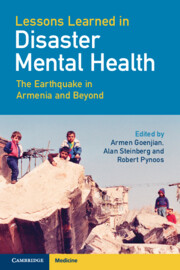Book contents
- Lessons Learned in Disaster Mental Health: The Earthquake in Armenia and Beyond
- Frontispiece
- Lessons Learned in Disaster Mental Health: The Earthquake in Armenia and Beyond
- Copyright page
- Contents
- Dedication
- Preface
- Contributors
- Chapter 1 The 1988 Spitak Earthquake in Armenia and the Implementation of the Psychiatric Outreach Program
- Chapter 2 Diaspora Therapists Working in the Earthquake Zone
- Chapter 3 Treatment Outcome among Early Adolescents Two Decades Post-Earthquake
- Chapter 4 Course and Predictors of PTSD and Depression among Not Treated Children and Adolescents over Two Decades
- Chapter 5 Conscience, Moral Injury, and Psychopathology
- Chapter 6 Natural Disasters and Relocation
- Chapter 7 Long-Term Course of PTSD and Depression Among Adults, Mediating and Moderating Factors in Recovery, and Current Trends for Treatment
- Chapter 8 How the Spitak Earthquake Contributed to our Understanding of the Genetics of PTSD and Associated Disorders
- Chapter 9 Epidemiology of Disasters and the Spitak Earthquake
- Chapter 10 Traumatic Stress Conceptual Framework
- Chapter 11 Memoirs of the Spitak Earthquake
- Chapter 12 Lessons Learned from the Spitak Earthquake and Other Catastrophic Disasters
- Index
- Plate Section (PDF Only)
- References
Chapter 10 - Traumatic Stress Conceptual Framework
Published online by Cambridge University Press: 20 May 2022
- Lessons Learned in Disaster Mental Health: The Earthquake in Armenia and Beyond
- Frontispiece
- Lessons Learned in Disaster Mental Health: The Earthquake in Armenia and Beyond
- Copyright page
- Contents
- Dedication
- Preface
- Contributors
- Chapter 1 The 1988 Spitak Earthquake in Armenia and the Implementation of the Psychiatric Outreach Program
- Chapter 2 Diaspora Therapists Working in the Earthquake Zone
- Chapter 3 Treatment Outcome among Early Adolescents Two Decades Post-Earthquake
- Chapter 4 Course and Predictors of PTSD and Depression among Not Treated Children and Adolescents over Two Decades
- Chapter 5 Conscience, Moral Injury, and Psychopathology
- Chapter 6 Natural Disasters and Relocation
- Chapter 7 Long-Term Course of PTSD and Depression Among Adults, Mediating and Moderating Factors in Recovery, and Current Trends for Treatment
- Chapter 8 How the Spitak Earthquake Contributed to our Understanding of the Genetics of PTSD and Associated Disorders
- Chapter 9 Epidemiology of Disasters and the Spitak Earthquake
- Chapter 10 Traumatic Stress Conceptual Framework
- Chapter 11 Memoirs of the Spitak Earthquake
- Chapter 12 Lessons Learned from the Spitak Earthquake and Other Catastrophic Disasters
- Index
- Plate Section (PDF Only)
- References
Summary
This chapter provides an overview of the components of the evolving conceptual model since the 1988 Spitak earthquake that guided the intervention and research arms of our work in Armenia. With the concept of traumatic stress as the gateway to post-trauma sequelae and recovery, we recognized the important contributions made by post-trauma adversities and the pervasiveness of trauma and loss reminders in the aftermath. Individual and ecological factors were seen as making powerful contributions to the impact and course of recovery, especially in terms of factors associated with resistance, resilience, vulnerability, adjustment, maladjustment, and pathology. The traumatic stress pathway is embedded in a developmental perspective, with the understanding that child, adolescent, and adult development plays an overarching role across all aspects of the conceptual framework. In addition, cultural and religious factors are also seen as integral. Implications of the conceptual model for data collection metrics and methodology, as well as intervention strategies are also discussed.
- Type
- Chapter
- Information
- Lessons Learned in Disaster Mental HealthThe Earthquake in Armenia and Beyond, pp. 162 - 178Publisher: Cambridge University PressPrint publication year: 2022

